 “Bee” Mindful When Selecting Plants for Pollinators
“Bee” Mindful When Selecting Plants for Pollinators
by Nini Connor, Sumter County Master Gardener, Master Naturalist
If you are creating or enhancing a pollinator habitat in your yard, take time to ensure you have plants for your project that are not only good for the butterflies and bees, but also good for the environment. We have all been there in a plant store or a butterfly garden, where we see a beautiful plant and believe is a “perfect” plant for our own slice of paradise. Little might you know that years down the road, those plants may be invasive and could become a pest – if not a menace – to your garden and the environment.
Plants marketed as fast-growing, maintenance-free, or quick-spreading, might be garden attackers in disguise. You’d be surprised how many common plants are trouble masquerading as something beneficial. Next time you get ready to add a plant to your space, arm yourself with a little knowledge about invasive plants and aggressive plants that will, in time, do more harm than good.
Invasive plants are those species that outcompete native varieties and rapidly grow out of control. They thrive against all the odds and are difficult to eradicate. While not technically invasive, aggressive growers multiply quickly, but aren’t necessarily capable of overtaking your property and competing with native flora. Did you know that invasive species are one of the biggest threats to biodiversity, second only to habitat loss? Invasive plant species can rapidly change wild habitats and Florida has almost 200 invasive plant species. Ecological Impacts of these invasive plants can alter fire regimes, alter hydrology, are not usually a preferred food source for native species, alter habitat composition, reduce biodiversity, shade out native species, can create monocultures, increase erosion, reduce recreation opportunities, impact crop production, increase cost of goods and reduce property values.
These invasive and aggressive species can cause problems in your garden. It pays to be aware of sneaky invaders since there’s always a chance that tricky plants might be sold at your local garden center, propagated by friends and organizations, without you even knowing.
Here are a few common invaders.
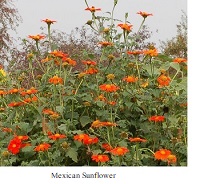
 Mexican Sunflower (Tithonia diversifolia) is a striking plant, however, there is bad news about this beauty; it is listed by the University of Florida as highly invasive. DO NOT PLANT! It will spread not only throughout your garden but into neighboring gardens and forests. Another cultivar of Mexican Sunflower is (Tithonia rotundifolia) is a smaller version with orange flowers. While it is not listed as an invasive plant, its rate of use and introduction increases the plants growing in cultivation and will continue escaping and spreading, it becomes increasingly likely that further naturalizations and invasions of this species will occur. Why not plant the Florida native Black-Eyed Susan (Rudbeckia hirta) which is easy to grow and tough as nails, making it an excellent choice for pollinator gardens.
Mexican Sunflower (Tithonia diversifolia) is a striking plant, however, there is bad news about this beauty; it is listed by the University of Florida as highly invasive. DO NOT PLANT! It will spread not only throughout your garden but into neighboring gardens and forests. Another cultivar of Mexican Sunflower is (Tithonia rotundifolia) is a smaller version with orange flowers. While it is not listed as an invasive plant, its rate of use and introduction increases the plants growing in cultivation and will continue escaping and spreading, it becomes increasingly likely that further naturalizations and invasions of this species will occur. Why not plant the Florida native Black-Eyed Susan (Rudbeckia hirta) which is easy to grow and tough as nails, making it an excellent choice for pollinator gardens.
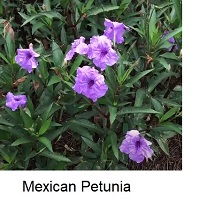
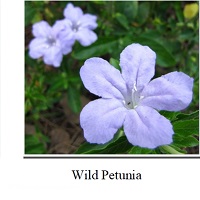 The Mexican Petunia is an evergreen, shrubby, rhizomatous perennial that can form colonies of stalks standing 3-4’ tall in the wild, but 2-3’ tall in gardens. Tubular, 5-lobed lavender to violet and white-colored flowers bloom in loose purple-stemmed clusters from the upper leaf axils. The smaller variety of this invasive plant, standing at less than a foot tall, is known as Dwarf Mexican Petunia. While these are very pretty plants, they are invasive and non-native to Florida; they are wolves in sheep’s clothing.
The Mexican Petunia is an evergreen, shrubby, rhizomatous perennial that can form colonies of stalks standing 3-4’ tall in the wild, but 2-3’ tall in gardens. Tubular, 5-lobed lavender to violet and white-colored flowers bloom in loose purple-stemmed clusters from the upper leaf axils. The smaller variety of this invasive plant, standing at less than a foot tall, is known as Dwarf Mexican Petunia. While these are very pretty plants, they are invasive and non-native to Florida; they are wolves in sheep’s clothing.
This plant invades habitats rapidly and is very adaptable to all kinds of environmental conditions. Once established in the wild, plants are very difficult to eradicate Even if it is a sterile cultivar, these plants can spread invasively through self-seeding and rhizomes, which can both float in water. Do not plant Mexican Petunia in the landscape or in pots. You can remove small groups of this plant by hand-pulling. Mexican Petunia can also re-sprout from crowns or rootstocks, so all the vegetative material has to be removed to prevent regrowth. As a native alternative, why not try Wild petunia (Ruellia caroliniensis).
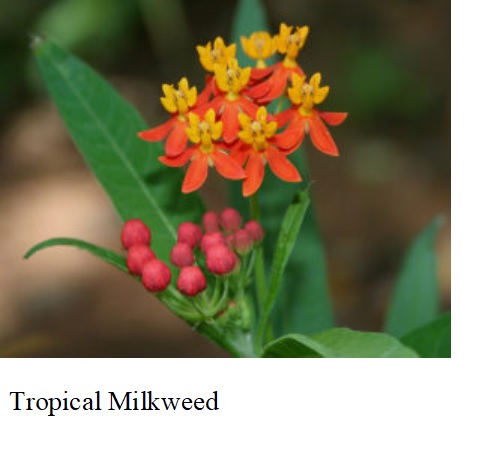
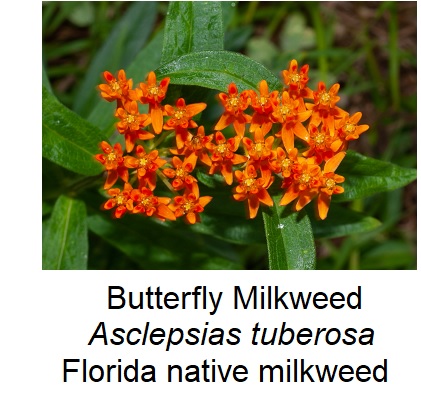 Tropical milkweed (Asclepias curassavica) is native to Mexico and Central America. It is widely available at Florida’s mainstream nurseries and big-box stores because it is easy to grow. While not technically considered invasive and used by butterfly enthusiasts, tropical milkweed can potentially harm Monarch butterflies in several ways.
Tropical milkweed (Asclepias curassavica) is native to Mexico and Central America. It is widely available at Florida’s mainstream nurseries and big-box stores because it is easy to grow. While not technically considered invasive and used by butterfly enthusiasts, tropical milkweed can potentially harm Monarch butterflies in several ways.
Commercially grown Tropical milkweed plants are sometimes treated with systemic insecticides to keep pests off of them, giving them a better appearance at retail nurseries. However, the chemicals can harm Monarch caterpillars that feed on their leaves.
Tropical milkweed has been linked to the transmission of Ophryocystis elektroscirrha (OE), a protozoan parasite. When OE spores infect milkweed leaves, they can be carried on the bodies of adult butterflies, spreading the infection. Microscopic spores on the bodies of infected caterpillars are spread to eggs, and infected larvae may not emerge from pupal stage or may emerge as very weak adults. Since tropical milkweed tends to not die back in the winter months as native milkweed does, it can have a much heavier load of this parasite.
The use of non-native Tropical milkweed also is believed to encourage Monarchs to overwinter in Central Florida instead of migrating, making them more susceptible to OE. The plant may escape into natural areas, causing further disruption of migration paths, and possibly crossbreeding with native species. By staying in Florida and continuously breeding, Monarchs risk death from food shortages, cold temperatures, and disease.
Although not documented scientifically, the higher concentration of cardenolides toxin in Tropical milkweed also may be detrimental to the Monarch caterpillar. The alternative is to seek out true native-to-Florida milkweed and encourage nurseries to supply it!
Learn to recognize and identify the invasive plants in your community. Removing these plants from your property can help eliminate a source of further spread. Care should be taken when removing these plants and proper disposal techniques followed. You might wonder how, using these plants could possibly be that detrimental, even if you keep an eye on their spread. Well, a good place to start helping with the problem of invasive plants is with your own landscape. Do your research. Before adding a plant to your garden or landscape, do a quick online search to find out about it. Always do your homework before planting something new. While aggressive plants won’t necessarily take over your entire yard and aren’t always considered invasive, they may be tougher to handle and care for, and there are better options.
Florida’s environment allows even small, seemingly insignificant plants to quickly spread out of control. Help make a positive impact in the community and educate yourself, and equally importantly, others about invasive plants!
Related Links
- Native Milkweeds for Monarchs
- Asclepias Turberosa
- Butterflies and Other Wildlife
